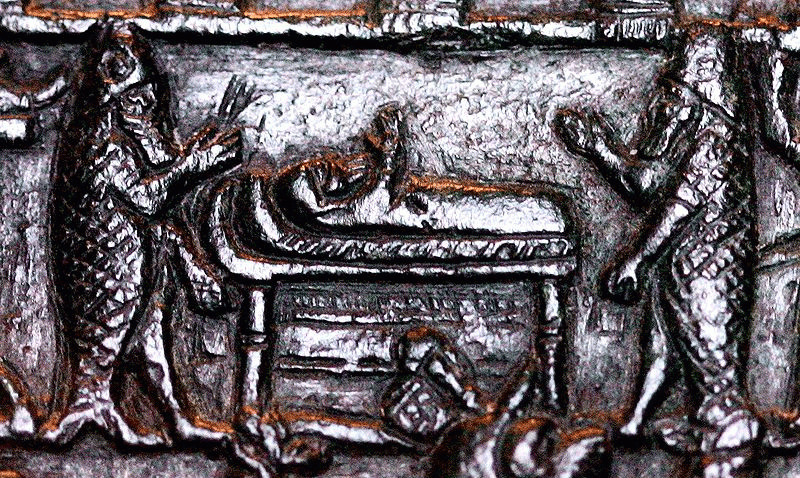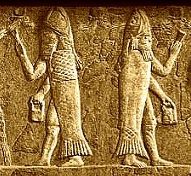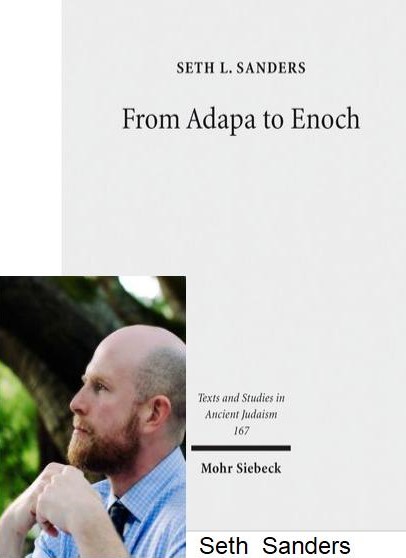| Continuing to share my reading of Seth Sanders’ From Adapa to Enoch, Scribal Culture and Religious Vision in Judea and Babylon, last discussed at Scholars, Divinities and How the Cosmos was Understood “Scientifically” B.C.E. |
–o–
Masks are powerful things. They can change your personality. Well, the word persona originally meant mask, a mask worn by an actor. I once attached a cut-out of a face of a leading political figure to a stick and held the face up in front of my own and walked through busy streets doing whatever as part of a political protest. Without the mask there is no way I could have acted the way I did. Acted. Actor. Mask. But we know it’s all pretence.When ancient Mesopotamian exorcists wore masks there was less sense of pretence. The mask brought one into the presence of gods.
We have seen the texts in which the exorcist claims, I am Adapa! Seth Sanders asks the obvious question:
But how seriously may we take these claims?
He gives a hint to the answer in his next sentence:
In fact there are deeply rooted semantic connections in Sumerian between essences, emblems, and masks.

The Essence of Things: me
Sanders reminds his readers of what “is well known”. Caution: he means “well known” to scholarly readers. This is not a book for the everyday lay reader. There is no clear introductory definition of apkallu, a key term throughout, and an outsider like myself only picks up his meaning from context and double checking via Google. Even abbreviations are not explained, it being evidently assumed readers will not need to be told that CAD refers to the Assyrian Dictionary of the Oriental Institute of the University of Chicago. To grasp the full flow of his argument I sometimes find myself having to renavigate earlier parts of a chapter from points that are explicitly identified as salient in its conclusion. But that’s one of the reasons I wanted to do this blog: to take such “hidden learning” from the ethereal halls of academia and give plebs like me an opportunity to know what “they are saying up there.”
As is well known, the Sumerian me represent the divine powers essential to the constitution and functioning of a host of institutions belonging to the spheres of culture and religious life. But in fact every element of the universe was understood as having its own distinctive me – its essence. As Cavigneaux as well as Oppenheim himself showed, the term reaches back into the earliest written texts. Already in the earliest connected Sumerian texts of the mid-third millennium we find the me nam-nun-kam, literally, “me of princeliness” and me nu-hal-hal and [me] nu-ha-lam “me of that which cannot be destroyed.” Woods argues [unpublished paper] that the word is likely derived from the Sumerian verb “to be,” with which it shares the same phonological shape, leading to a relationship “that which is” > “essence.” (Sanders, 80)
So far so good. Essences are abstract. But there’s more. They are also very concrete.
The me, the essences, can be picked up, held up, stolen from someone and given to another, ridden, knocked over, hidden, “or stuck in a corner”. There is evidence that the term was also once synonymous with the idea of self or one’s person — and hence possessed by all entities.
The term me is part of another word, melammu, a “burning or radiant me” = “radiance, supernatural awe-inspiring sheen (inherent in things divine and royal).” But it can be removed from those who possess it, too, and the language used is that of removing a cloak or a crown in which the awe-inspiring sheen and terror is housed. Concepts of self could be attached to objects such as a crown or a mask.
What is most distinctively Mesopotamian about this concept of the self, then, is that it is an alienable essence. Inextricably bound with identity, it is nonetheless material and mobile – it can be taken. The me-lam, burning or radiant me, . . . a numinous radiance or blinding mask of light, is similarly both a mark of inherent divinity or magnificence and an alienable object that can be snatched away or handed off (Oppenheim 1943, Cassin 1968).
The universe itself, or rather, “the me [translated in this context as “plans”] of heaven and earth”, is kept in order by the powers of the seven divine fish-like sages or apkallu. (Mere human descended apkallu do not have such powers but only “great understanding”.) (pp. 53-55) As per a protective ritual:
1-2 Incantation: Uanna, who completes the plan of heaven and earth, 3^1 Uanneduga, endowed with broad mind, 5 Enmeduga, ordained with a happy fate, 6 Enmegalamma, formed in a house, 7 Enmebulugga, who grew in a field, 8 Anenlilda, incantation-priest of Eridu, 9 Utuabzu, who ascended to heaven: 10-11 They are the seven brilliant Purâdu-fish, Puradu-i’ish of the sea; 12-13 Seven apkallü formed in the river, who keep the plans [= me] of heaven and earth in order. 14-15 Nungalpiriggal, apkallu of Enmerkar, who brought Ishtar down from heaven into the Eanna. 16-17 Piriggalnungal, formed in Kish, who angered Adad in heaven so that 18-19 he did not let there be rain or vegetation in the land for three years. 20-23 Piriggalabzu, formed in Adab, who hung his seal on a Seal-fish and thus angered Enki in the Abzu so that a fuller struck him with his own seal. 24-27 Fourth, Lu-Nanna, two-thirds apkallu, who drove a dragon out of the Eninkiag-nunna, the Istar temple of Shulgi. 28-29 Four apkallu of human descent, who Lord Enki endowed with broad understanding. 30 Ritual action: Before the seven Purâdu-apkallu who are striped with plaster and black paste, 31 which are drawn on the wall of the side of the sanctuary, you recite (the above).
But to return to the exorcist who wears a mask, another persona, that of a divine being . . . .
Keep in mind that the me, the essence, the self, the person/persona is a transferrable entity. It can belong to a person and reside in an object.

Here are the exorcist’s words, or rather, the words being spoken through the exorcist:
I belong to Ea
I belong to Damkina
I am the messenger of Asalluh [= the god of exorcism]
The exorcist describes the demons he is about to encounter:
The evil Utukku-âemon who murders a healthy victim in the steppe,
And the evil Alu demon who covers his victim like a garment
He then diagnoses the disease and its cause:
They approached the distraught man, they deposited asakku-disease in his body, since there was already an evil oath in his body, they deposited harmful blood in his body
Having done so, the exorcist then addresses the demons directly:
Be adjured by Ningirsu, lord of the weapon, evil Utukku-demon, alu demon, ghost, sheriff-demon, god, and Baliff-demon
Now the exorcist makes the authority of his words known all the more emphatically:
[Ea] superimposed . . . his pure incantation upon mine
He superimposed his pure mouth upon mine
He superimposed his pure spittle upon mine
He superimposed his pure prayer upon mine
. . . .
My incantation is actually Ea’s, my spell is actually Asalluhi’s
It is not the exorcist who is speaking. It is not even the exorcist’s spittle that they see as he speaks.
The exorcist bears no responsibility for what is being said or done. The words heard are not his words or even his voice. Another tablet relating to the same incantation says:
Ea recites the incantation, Ningirgimma casts the spell, Ea’s spittle, Ea’s incantation, Ea’s saliva, Ea’s command!
The exorcist is not even addressing the patient. It may well be that the patient, if not a scribe, had no idea what was going on in the conversation. The spirit powers using the exorcist are addressing the demons, the cause of the illness. The patient is merely “an innocent bystander”.
The paradoxical mechanism of the exorcist’s power is this: the speaker empowers himself by adopting a mask that is at once ancient and authoritative yet makes minimal claims to creativity and responsibility – a widespread feature of religious language (Du Bois 1986).
The Secret of the Mask
Here the relevance of the above discussion of me becomes more apparent.
From the early first millennium there appears a new form of incantation for healing in Mesopotamia, the Maqlû or “burning”, the name referencing both a purifying fire and burning effigies of witches. Its second incantation begins:
O Underworld, Underworld,
Gilgamesh is the enforcer of your Oath!
Whatever (magic) you (witches) have performed, I know.
Whatever (magic) I may perform, you do not know.
The wearer of the mask knows what the witches have done but they do not know what he is doing now. “I (the mask wearer) can see you but you cannot see me.” Sanders reads the text as further claiming that there is no-one available who can undo what the witches have done. There is no-one available to fix the problem. The god Anu then asks rhetorically,
Whom shall I send?
The god knows the one he is sending, though. He is not sending a spirit power to stand behind and protect the exorcist; he is sending the exorcist as that divine power:
The speaker then sounds the old theme of the water-carrying, known from many [Whom shall I send?] incantations, but there is a crucial change: this time it is the speaker himself who is carrying the purifying water to the gods. He has advanced himself to the level of the daughters of heaven by acting as a water-carrier; the action becomes reciprocal as he asks them to purify him for his mission. . . .
For the first time in the history of the [Whom shall I send?] theme, the speaker himself claims to be the one sent. (Sanders 88-89)
Anu and Antu sent me, (saying:)
“Whom shall I send to the Mistress of the Steppe . . .”I am sent – I go! I am ordered
-I speak!
To /pun: against the power of/ my warlock
Asalluhi, lord of exorcism, has sent me!
“I am Sent” — but Where?
Here, for the first time, the divine messenger is not sent to come down from heaven to earth to solve the problem in the here-and-now but to go out from earth to the Mistress of the Steppe in order to prepare to indict the witch in the court of the gods. (Sanders, 89. Italics original, bolding mine)
The gods of the night sky are called up and the celestial gods are called down to assemble for the judgment.
The Maqlû scribes have written an incantation to prepare
the speaker to plead in front of the courts of the gods. He enters a kind of collapsed other worldly space that renders the authorities of heaven and the underworld accessible at once. The changes worked in the speaker’s identity are part of a drama of cosmic judgment which it is the business of this ritual to precipitate.
Something has gone wrong with the world. Demons are responsible. The speaker as a divine messenger heads “outward to the divine court”.
The ritual functions to place the speaker in a role of divine knowledge and power such that he can elicit cosmic judgment against this evil force and set the universe back in order. (Sanders, 89)
The speaker has invested new meanings in old formulae like “Who shall I send?” to that he himself becomes the divine messenger, possessing divine knowledge and power, knowing the witches responsible and empowered with authority of magic to travel to the otherworld and accuse before all the assembled gods the guilty witch.
It’s a fascinating story. But we have only seen the exorcist in action so far. Next, we’ll look at how another scholarly specialist, the diviner, was able to meet the gods.
Sanders, Seth L. 2017. From Adapa to Enoch: Scribal Culture and Religious Vision in Judea and Babylon. Tübingen, Germany: Mohr Siebeck.
If you enjoyed this post, please consider donating to Vridar. Thanks!


